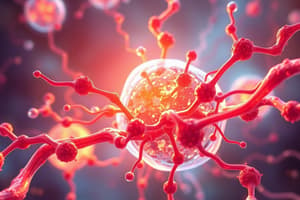Podcast
Questions and Answers
What is the main function of integrins in cell-to-cell adhesion?
What is the main function of integrins in cell-to-cell adhesion?
- Enable leukocyte rolling
- Allow cells to adhere to each other and the extracellular matrix (correct)
- Resemble the variable regions of antibodies
- Recognize specific carbohydrate moieties
Which type of cell adhesion molecules is primarily involved in leukocyte rolling?
Which type of cell adhesion molecules is primarily involved in leukocyte rolling?
- Glycoproteins
- Integrins
- Selectins (correct)
- Immunoglobulin superfamily CAMs
What is the defining feature of immunoglobulin superfamily CAMs?
What is the defining feature of immunoglobulin superfamily CAMs?
- Recognize specific carbohydrate moieties
- Resemble the variable regions of antibodies (correct)
- Contain a transmembrane region
- Enable cell migration
Which type of cell adhesion molecules binds to extracellular matrix components?
Which type of cell adhesion molecules binds to extracellular matrix components?
What role do selectins play in cell-to-cell adhesion?
What role do selectins play in cell-to-cell adhesion?
How are integrins structurally different from selectins?
How are integrins structurally different from selectins?
What is a significant challenge faced by researchers in cell adhesion research?
What is a significant challenge faced by researchers in cell adhesion research?
What type of adhesion involves cells expressing different adhesion molecules interacting and adhering to each other?
What type of adhesion involves cells expressing different adhesion molecules interacting and adhering to each other?
Which statement best describes the role of cell adhesion molecules in tissue formation and maintenance?
Which statement best describes the role of cell adhesion molecules in tissue formation and maintenance?
How do CAMs contribute to cell signaling and communication?
How do CAMs contribute to cell signaling and communication?
Which factor influences the regulation, expression, and function of CAMs?
Which factor influences the regulation, expression, and function of CAMs?
What biological process do CAMs guide during embryonic development, wound healing, and immune responses?
What biological process do CAMs guide during embryonic development, wound healing, and immune responses?
Flashcards are hidden until you start studying
Study Notes
Cell-to-Cell Adhesion: A Foundational Pillar of Cellular Communication
Cell-to-cell adhesion is a fundamental process in multicellular organisms, allowing cells to interact and organize into complex structures like tissues and organs. This intricate dance between cells is orchestrated by specialized molecules, known as cell adhesion molecules (CAMs). In this article, we'll delve into the fascinating world of cell adhesion, exploring the diverse roles of CAMs in maintaining tissue integrity, directing cell migration, and facilitating communication between cells.
The Diverse Nature of Cell Adhesion Molecules
Cell adhesion molecules are a vast and heterogeneous group of proteins found on the surface of cells, with three main categories:
-
Integrins: These transmembrane glycoproteins consist of an extracellular domain, a transmembrane region, and a cytoplasmic tail. They bind to extracellular matrix (ECM) components and other CAMs, enabling cells to adhere to each other and the ECM.
-
Selectins: These CAMs are type I transmembrane glycoproteins that recognize specific carbohydrate moieties on glycoproteins and glycolipids. Selectins are primarily involved in leukocyte (white blood cell) rolling and initial attachment to the endothelium during immune responses.
-
Immunoglobulin superfamily (IgSF) CAMs: This group of CAMs contains extracellular domains that resemble the variable regions of antibodies. IgSF CAMs play crucial roles in cell adhesion, cell signaling, and immune response regulation.
The Mechanisms of Cell Adhesion
Cell adhesion involves a series of processes that facilitate the formation and maintenance of cellular contacts.
-
Homophilic adhesion: Cells expressing the same adhesion molecules on their surfaces interact and adhere to each other.
-
Heterophilic adhesion: Cells expressing different adhesion molecules interact and adhere to each other.
-
Adhesion junctions: Cells can form specialized junctions, such as tight junctions, adherens junctions, and desmosomes, which provide structural integrity and regulate cell migration.
The Biological Significance of Cell Adhesion
Cell adhesion is indispensable for various biological processes, including:
-
Tissue formation and maintenance: Cell adhesion molecules facilitate the assembly and organization of cells into functional tissues and organs.
-
Cell migration and morphogenesis: CAMs guide cell movement during embryonic development, wound healing, and immune responses.
-
Cell signaling and communication: CAMs act as signaling molecules, promoting cellular communication and regulating cellular processes.
Challenges in Cell Adhesion Research
While CAMs have been well-characterized in various contexts, our understanding of cell adhesion is still incomplete. Researchers face several challenges, including:
-
Diversity and complexity: The vast number of CAMs, their multiple interactions, and the dynamic nature of cell adhesion make it difficult to dissect their roles and functions.
-
Cellular context: The regulation, expression, and function of CAMs vary greatly depending on the cell type, tissue, and organism.
-
Disease implications: Altered cell adhesion is implicated in various diseases, including cancer, neurological disorders, and inflammation.
Conclusion
Cell-to-cell adhesion is a fascinating and essential process, orchestrated by cell adhesion molecules. The study of CAMs and their interactions has provided valuable insights into tissue formation and maintenance, cell migration, and cellular communication. As our understanding of cell adhesion continues to grow, we may uncover new opportunities to harness its potential for therapeutic applications and gain valuable insights into disease mechanisms.
Studying That Suits You
Use AI to generate personalized quizzes and flashcards to suit your learning preferences.



